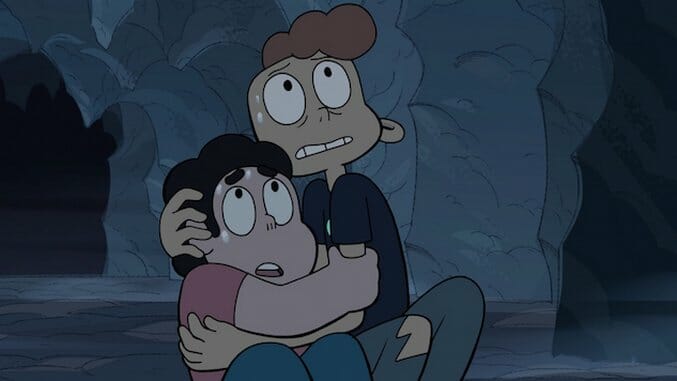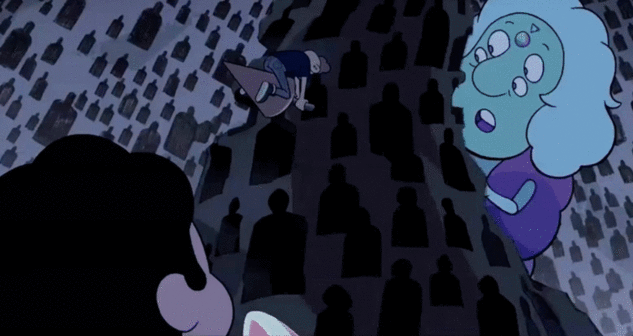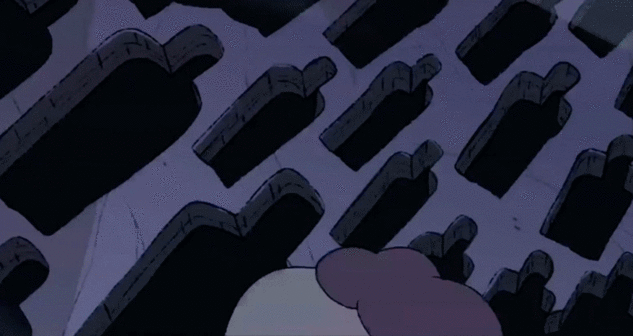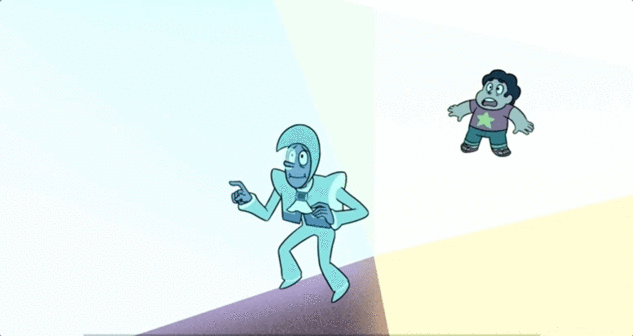Steven Universe Builds on Its Unorthodox Christ Allegory in “Wanted”
(Episodes 4.25 - 4.28)
Cartoon Network
From the moment Steven Universe and Lars were whisked away to Homeworld, a few things were pretty clear: 1) Steven would make it back to Earth; 2) Lars would get some redemption; and 3) some seriously groundbreaking stuff was about to happen.
The hourlong, four-part “Wanted” gives us all of this and more. It’s packed with shattering (pardon my pun) revelations, some of the best action sequences Steven Universe has ever aired, and the series’ typical love. And while parts of it feel a bit preachy and cheesy (particularly in “Lars’ Head,” the special’s final installment), I’m willing to tolerate a bit of heavy-handedness with the bold steps “Wanted” takes. We got a flippin’ on-screen death! In a kids’ show! And it was pretty brutal!
Not that death is imperative to entertainment’s value, of course. But it shows off Steven Universe’s progression into more mature themes and its trust in its young target audience. And it allows the further development of one of the series’ central allegories: Steven as a Christ figure.
Stesus wept.
And then Lars-arus—actually, I like Larzarus better, let’s go with that—comes back from the dead. It’s the greatest miracle Steven has performed in a long line of great miracles, most of which have dealt with healing. He’s brought sentience to watermelons and pumpkins; he’s given Lapis Lazuli back her wings; he’s healed Connie’s eyesight and Eyeball’s gem.
Now, I wasn’t raised on the New Testament, but the story of Jesus of Nazareth is culturally ubiquitous enough that Steven’s pattern of creating life and restoring health looks awfully familiar. Healing Lapis’ wings maps onto restoring a paralyzed man’s ability to walk. Connie wasn’t blind from birth, but wearing glasses is a close analogue. Resurrecting Larzarus practically seals the deal on the metaphor.
The events of “Wanted” aren’t the first time the Steven-as-Jesus line has arisen so strongly. Back in December, “Three Gems and a Baby” made the allegory quite explicit. It was a Christmas special, yes, but that doesn’t make the image of baby Steven getting gifts from the three Crystal Gems any less potent—especially when you consider that Steven contains his mom’s full spirit where his belly button should be. That, of course, is the closest parallel. We still haven’t seen how Steven was conceived and probably never will, because Cartoon Network would never allow it, but odds are it was some sort of immaculate process, given that Steven appears to be the only half-Gem in the galaxy.
In many ways, it makes sense that Steven Universe takes inspiration, purposefully or subconsciously, from Jesus, who spent his days preaching about the importance of love and acceptance, walked among the lepers whom society shunned, and showed compassion for the poor. Millennia before the term “marginalized community” entered the lexicon, Jesus was working for the downtrodden, fighting against the religious and political mores of Judea and Rome.
Steven Universe has many of the same goals despite its vastly different temporal context. For example, Homeworld treats the “off colors” we meet in “Wanted” the same way Jesus’ society treated lepers (worse, even), but Steven embraces them immediately—note his calm in stark contrast to Lars’ freaked-out reaction. And in general, the series has devoted ample time and representation to LGBTQ issues, feminist perspectives, abusive relationships and people with mental disorders. In Steven Universe, groups that have been marginalized in the past (and continue to be in the present), discover both an individualized chemistry with the show and a common rallying point. And as early Christians did with Jesus, fans of Steven Universe would probably follow Rebecca Sugar and company to the ends of the Earth.
There is, however, a major difference between the two stories. The sins for which Jesus died are those of the general population. The sins for which Steven was (and is) prepared to die are those of his mother—the God-like figure in this allegory. In fact, because Steven literally took his mother’s place upon his birth, we can call the shattering of Pink Diamond his original sin. “Rose Quartz did it, and I’ve got her gem, so I’m the one who’s gotta pay for this,” he tells his Zircon lawyer (an excellent Amy Sedaris) in that idea’s most straightforward expression thus far.
Effectively, therefore, the show flips the metaphor on his head; Jesus didn’t have to forgive God, nor could he have done, if we assume that the Christian god is omnibenevolent. Steven, on the other hand, will need to forgive his mother if he is ever to embrace himself as an independent human being. Because of this reversal, Steven Universe can address self-love in a way that biblical lore, which typically focuses more on loving others, can’t do quite so directly. The result is a sort of hybrid value system that applies Christian love universally—not only to all beings, regardless of their mental state or physical appearance, but also to one’s own self, regardless of our flaws. This is important for the series’ target audience of kids, who often struggle with self-esteem as they grow, but it’s even more important for the show’s many LGBTQ fans, a group that has historically been rejected by Judeo-Christian culture.
Now, it’s not Steven undergoing this transformation of self-love in “Wanted”: It’s Lars. Steven Universe was pretty obviously going to redeem him, but the series pulled off the redemption flawlessly—first through the glorious, cutting dialogue of “Stuck Together,” then through Lars’ self-overcoming and sacrifice in “Off Colors,” and finally in his ownership of his resurrected Larzarus persona in “Lars’ Head.” He keeps his neuroticism and slight whininess throughout—those traits will always be part of him—but in his moment of absolution, he transcends his fear and comes to love his own self through an act of utter selflessness. “I think that’s the coolest thing I’ve ever done in my life,” he says in the midst of the battle, just before his death and rebirth. And it’s not the intense action sequence that Lars finds cool; it’s the freedom from his doubts. For once, he realizes how badass he is.
And then he becomes Larzarus, and with a second shot at life, he’s committed to his new role as protector of the Off Colors… and as the portal between Earth and Homeworld. That’s totally not going to be important in the future.
Now, about that trial…
So Stesus has helped Lars find a sense of self-worth, just as he did with Amethyst in Season Three. The parallels between the two arcs are uncanny. But still, Steven has not come to an appreciation of himself, largely because he hasn’t forgiven his mother for shattering Pink Diamond… wait, what? There’s a cover-up? Everything we know is a lie?
We can’t prove anything at this point, but it sure looks like Yellow Diamond played a major role in the demise of Pink. Steven’s public defender (I’m still amazed Homeworld has public defenders) puts together the puzzle pieces, and if her facts are correct, she’s absolutely right: It makes no sense that Rose Quartz could’ve gotten close enough to Pink Diamond for a shattering attack, unless Rose also poofed Pink’s entire entourage and then Pink inexplicably didn’t defend herself. There’s no way any Gem besides a Diamond should be able to successfully take down a Diamond in a fair, one-on-one fight, it seems, especially after we witness the Diamonds’ vast powers—Blue can disable an entire room with her emotion, and Yellow can poof a Gem the way we would squish a bug. So the story has to have been concocted… right? Especially after the way that Yellow conducts herself in the aftermath of the Zircon’s accusation?
I can think of a few reasons why Yellow might have wanted to get rid of Pink, but my chief hunch is that Yellow was becoming jealous. When the Diamonds appear at the trial, they caress each other in a loving, comforting pose, with Yellow appearing to be in charge. We know that after more than five millennia, Blue is still grieving over Pink, almost as if she loved Earth’s overseer romantically. Meanwhile, Yellow can’t stand the Earth or the Zoo, repeatedly stating her desire to get rid of both and forget the whole affair. Perhaps Yellow, wanting to maintain control over Blue’s heart—whether out of misguided romantic feelings or determination to keep Blue focused—chose to dispose of her chief rival, then conveniently pin it on Rose Quartz, then attempt to wipe out the Earth completely to tie up the loose ends. This would fit perfectly with the series’ ideas of love, and specifically with Homeworld’s understanding of love: It exists, but it’s totally taboo, as we find out very viscerally from Topaz in “Stuck Together.” The Diamonds, who supposedly don’t allow emotion to cloud their civilization’s decisions, might see their own burgeoning love as something they could only express (or stamp out) by force.
Of course, this theory has a couple holes, namely the fact that Garnet seemingly admitted to Steven that Rose did, in fact, shatter Pink Diamond. But more important than the theory itself is its implication that Steven has needlessly labeled his mother a murderer. Rose Quartz’s exoneration would work wonders for Steven’s ability to love himself, but I think it would cheapen Steven Universe’s storytelling and thematic exploration. Regardless of your opinion upon the moral quandary that is “justified warfare,” it would be fascinating and incredibly mature if this series were to delve into the topic with brutal honesty and come out the other side with forgiveness.
I can understand why the Crewniverse would shy away from this—after all, even Avatar: The Last Airbender, which devoted an entire episode to Aang’s discussion with past Avatars about the idea of justified killing, didn’t go so far as to forgive it or to have Aang kill Fire Lord Ozai. But Steven Universe just killed a character on-screen, and even though Lars was only dead for about 30 seconds, it represented the seriousness the series is willing to take on. To shirk a discussion of Rose’s redemption would be uncharacteristic and disappointing.
The Bits
That massive, spiky white structure in the background of the Homeworld shots looks an awful lot like White Diamond. The question is whether it’s actually White Diamond or just a huge statue… either way, it’s more proof that White exists, and that we will might meet her at some point.
Any theory that Lion is somehow related to Pink Diamond is pretty much debunked now. At this point, actually, he’s evidence that Larzarus will be immortal.
I don’t know how Steven ever thought the pants-lasso idea was going to work. I can’t fault Lars for not really giving it a try. Also, why didn’t Steven just counter Aquamarine’s verbal daggers to Topaz by saying that Topaz could come live on Earth with the Crystal Gems?
When Steven was trying to pull Lars through his own head, I couldn’t help but picture the infamous inside-out teleportation scene from Galaxy Quest.
Blue Pearl’s courtroom sketches are high art.
Zach Blumenfeld hopes he will become as good a lawyer as Steven’s Zircon. Follow him on Twitter.



